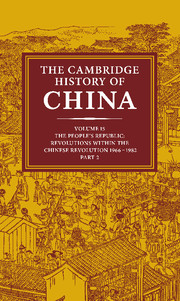Book contents
- Frontmatter
- 1 Mao Tse-tung's thought from 1949 to 1976
- PART I THE CULTURAL REVOLUTION: CHINA IN TURMOIL, 1966–1969
- PART II THE CULTURAL REVOLUTION: THE STRUGGLE FOR THE SUCCESSION, 1969–1982
- PART III THE CULTURAL REVOLUTION AND ITS AFTERMATH
- PART IV LIFE AND LETTERS UNDER COMMUNISM
- 9 The countryside under communism
- 10 Urban life in the People's Republic
- 11 Literature under communism
- PART V THE SEPARATED PROVINCE
- Epilogue: the onus of unity
- Appendixes: meetings and leaders
- Bibliographical essays
- Bibliography
- Index
- Map 1: China’s physical features
- Map 2. PRC: political (Wade–Giles romanization)
- Map 3. PRC: political (pinyin romanization)
- Map 7: Population
- References
11 - Literature under communism
from PART IV - LIFE AND LETTERS UNDER COMMUNISM
Published online by Cambridge University Press: 28 March 2008
- Frontmatter
- 1 Mao Tse-tung's thought from 1949 to 1976
- PART I THE CULTURAL REVOLUTION: CHINA IN TURMOIL, 1966–1969
- PART II THE CULTURAL REVOLUTION: THE STRUGGLE FOR THE SUCCESSION, 1969–1982
- PART III THE CULTURAL REVOLUTION AND ITS AFTERMATH
- PART IV LIFE AND LETTERS UNDER COMMUNISM
- 9 The countryside under communism
- 10 Urban life in the People's Republic
- 11 Literature under communism
- PART V THE SEPARATED PROVINCE
- Epilogue: the onus of unity
- Appendixes: meetings and leaders
- Bibliographical essays
- Bibliography
- Index
- Map 1: China’s physical features
- Map 2. PRC: political (Wade–Giles romanization)
- Map 3. PRC: political (pinyin romanization)
- Map 7: Population
- References
Summary
THE INSTITUTION OF A SOCIALIST LITERATURE, 1949–1956
The organization of literary production
The first national Congress of Literature and Art Workers assembled 650 delegates in Peking from 2 July through 19 July 1949, some three months before the formal establishment of the People's Republic itself. Mao Tse-tung, Chou En-lai, and other national figures emphasized by their presence the importance the leadership would attach to the development of a new socialist culture and the establishment of the necessary organs for its direction. The umbrella organization under which all cultural activities were to be coordinated was later (1953) to be christened the All-China Federation of Literary and Art Circles. Beneath this umbrella have come into existence, through four decades and with a pronounced hiatus at the time of the Cultural Revolution (roughly the ten years 1966–76), ten unions, covering fiction and poetry (the Writers Union), drama (the Dramatists Union, the largest of all because it incorporates performers as well as writers), cinema, music, dance, fine arts, performing literature, folk literature, children's literature, and circus (this last the newest, established at its fourth congress, in November 1979).
Although the federation has been responsible for the important stock-takings during the four national congresses (1949, 1953, 1960, 1979), the central role in the ongoing work of the direction and development of the new literature has been played by the Writers Union. This organ, which traces its origins back at least to the patriotic associations formed from 1937 onward by Lao She, Kuo Mojo, and other eminent men of letters, provides a forum for writers, holding frequent discussion meetings in all parts of the country.
Keywords
- Type
- Chapter
- Information
- The Cambridge History of China , pp. 743 - 812Publisher: Cambridge University PressPrint publication year: 1991
References
- 1
- Cited by

